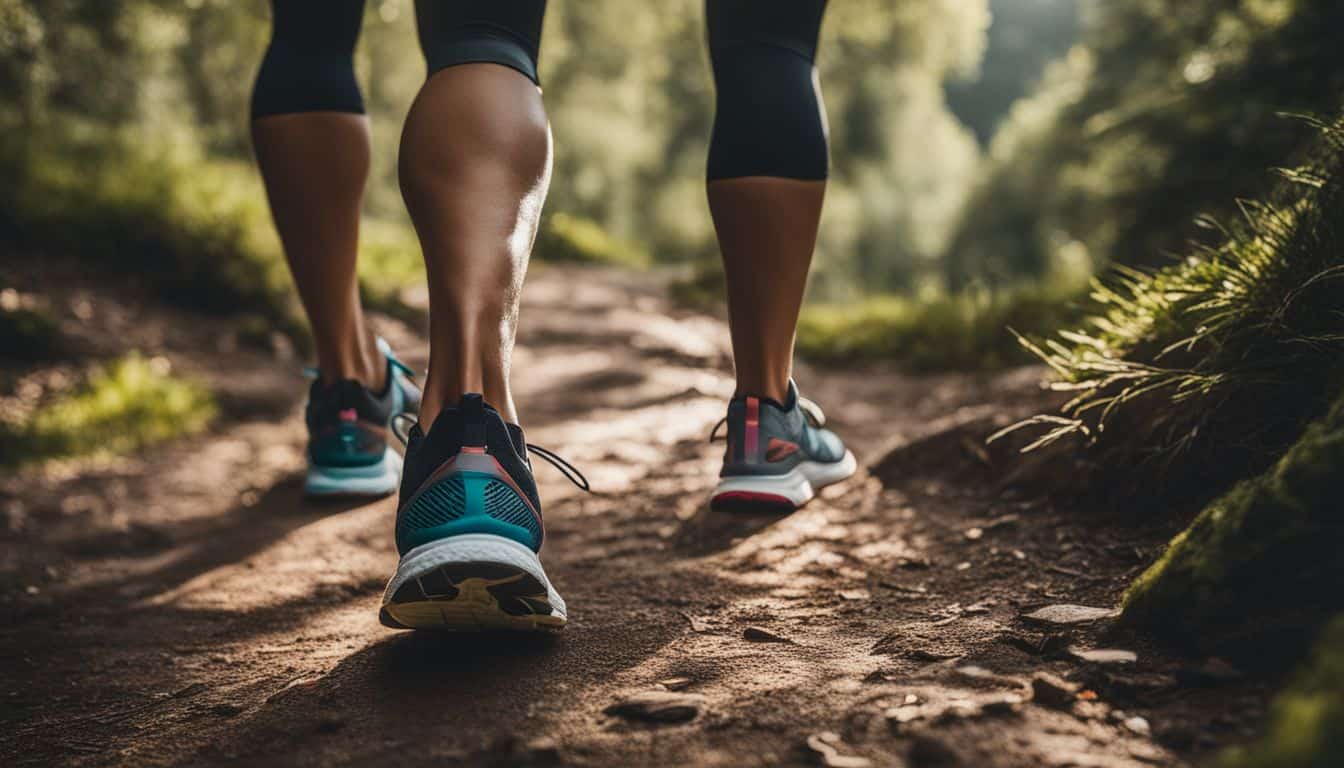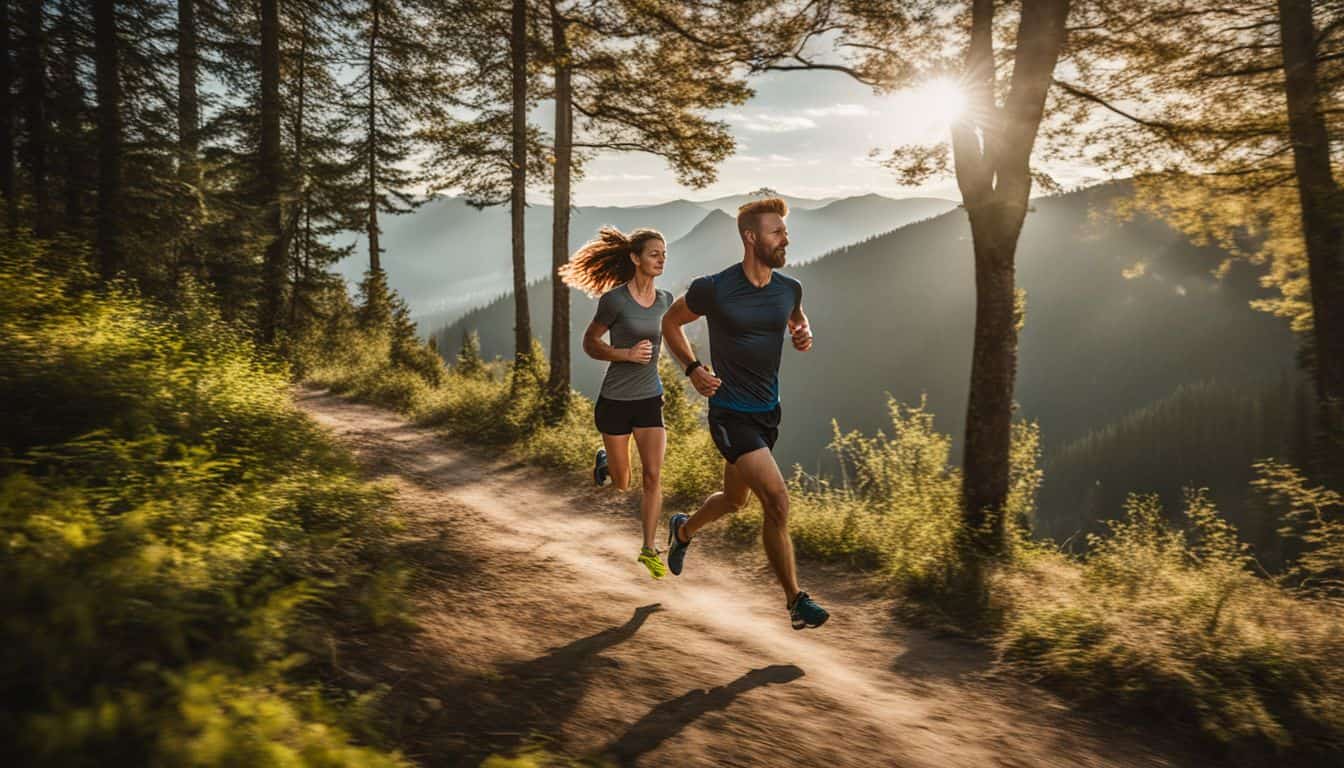Feeling a little swamped with the task of picking out just the right running shoes for basic training? Trust me, you’re not alone. Something that might surprise you is how much your choice in footwear can either drive or hinder your performance – it’s that important! In this blog post, we’ll be exploring 3 evidence-backed tips to guide you towards those dream shoes.
We’ll delve into understanding different shoe styles, conducting gait analysis and choosing the perfect fit based on your unique foot type. Let’s journey toward victory together one step at a time!
Key Takeaways
- Choose running shoes based on your workout type and surface to ensure safety and support during workouts.
- Consider your gait and running style when selecting running shoes to prevent injuries.
- Proper fit is crucial for comfort and injury prevention, so make sure the shoes are snug but not too tight.
- Match your shoe type to the terrain you will be running on (e.g., trail shoes for trails, road shoes for pavement).
- The midsole shape and cushioning of your running shoes play a significant role in impact absorption and stability.
- Understanding heel-to-toe drop can help you find a shoe that suits your running style and supports weak areas of your foot.
- Assessing your pronation type (overpronation, neutral pronation, supination) is important in choosing the right shoe features for support.
- Avoid common mistakes like buying the wrong shoe type or size, as it can lead to discomfort or injuries during basic training.
Tips for Selecting Running Shoes for Basic Training
Consider your workout type and surface when selecting running shoes for basic training.
Consider your workout type and surface
Think about how you workout. Are you jogging on a paved path? Maybe, running trails in the woods? Your workout type and surface are important to think about. Choosing shoes for where you run makes sure your feet stay safe during workouts.
Most shoes are made for one type of ground or another. The soles are different for each place you run. A shoe with a grippy sole is good for trail runs. Hard, flat soles are better for gym floors or roads.
Keep this in mind when looking at new running shoes.
Examine shoe options and features
Looking at shoe options and features is a key step. There are many kinds of running shoes out there. Some have more cushion, some are very light, and others offer extra support. Each one comes with its own set of features that you should think about.
Body mechanics like your gait can also affect what kind of shoe is best for you. The findings from the Delphi study show us this fact. It’s smart to have different pairs too based on the task or if you’re trying not to get hurt.
So when you pick out your running shoes, remember all these points!

Match your shoes to your running style and gait
Your shoes need to fit your running style and gait. Each runner has a different way they move their feet. This is called ‘gait’. Some runners’ feet roll inward, a term we call pronation.
Others’ feet may roll outward or stay neutral. There are shoes for each type of foot motion! If you pick the wrong type, you might get hurt when you run. A store that sells running shoes can watch how you run and help find the right shoe for your gait and style.
Do not forget this tip – it can save your feet from pain!
Understanding the Role of Running Shoes for Basic Training
Running shoes play a crucial role in basic training because they can improve your performance and protect your feet. The structure and anatomy of running shoes are designed to enhance your running experience.
They provide cushioning to absorb impact, stability to prevent injuries, and support for different types of foot pronation. When choosing running shoes, it’s important to consider the specific needs of your feet and the terrain you’ll be running on.
By understanding these factors, you can select the right pair of shoes that will provide optimal comfort and help you reach your training goals.
How Your Shoes Should Fit
Proper fit and sizing are crucial when it comes to running shoes. Read on to discover the key considerations for finding the perfect fit that will keep you comfortable and injury-free throughout your basic training.
Proper fit and sizing considerations
Choosing the right running shoes for basic training is crucial for your comfort and success. Here are some important things to consider when it comes to proper fit and sizing:
- The fit of a running shoe should be snug but not too tight. It should provide enough room for your toes to move comfortably.
- If a shoe feels too tight, it may be an indicator that you need a different size. Don’t settle for shoes that squeeze or pinch your feet.
- When trying on running shoes, walk around in them and pay attention to how they feel. They should feel comfortable and supportive, with no areas of pressure or discomfort.
- Proper fit should always be the determining factor in choosing running shoes, rather than relying solely on the size marked on the shoe box.
- Size can vary between shoe brands, so don’t assume that your usual size will be the same across all brands. Try on different sizes to find the best fit for you.
Choosing the Right Shoe for Your Running Surface
Consider the terrain you will be running on and choose a shoe that is specifically designed for that surface.
Different shoe options for various terrains
Choosing the right running shoe for different terrains is crucial. Here are some options to consider:
- Trail Shoes: These shoes have rugged outsoles and provide extra traction for off-road running on uneven surfaces like trails and dirt paths.
- Road Shoes: Designed for pavement and smooth surfaces, these shoes prioritize cushioning and lightweight construction for a comfortable road-running experience.
- Track Shoes: Built specifically for track surfaces, these shoes have spike plates or pins that offer better grip and traction on the track.
- Cross-Training Shoes: These versatile shoes are suitable for different terrains and activities, making them a good option if you engage in various types of workouts.
- Minimalist Shoes: Designed for runners who prefer a barefoot-like feel, these shoes have minimal cushioning and lower heel-to-toe drop.
Understanding Midsole Shape and Cushioning
The midsole shape and cushioning of your running shoes play a crucial role in providing impact absorption and stability while you run.
Impact absorption and stability
When it comes to running shoes, impact absorption and stability are crucial for preventing injuries. The midsole of the shoe plays a significant role in providing cushioning and absorbing shock during impacts.
It’s important to find the right balance of cushioning that effectively reduces the impact on your joints without increasing leg stiffness. Thicker midsoles generally offer more cushioning but may affect stability.
On the other hand, overly stiff midsoles can compromise comfort and increase the risk of injury. So, when choosing running shoes, consider their impact absorption capabilities and stability level to ensure a comfortable and injury-free running experience.
Importance of Heel-Toe Drop
Understanding the importance of heel-toe drop is crucial when selecting running shoes for basic training. Read on to discover how this factor can impact your performance and enhance your overall running experience.
Finding the right balance for your running style
When it comes to finding the right balance for your running style, one important factor to consider is the heel-to-toe drop of your running shoes. This refers to the difference in height between the heel and forefoot of the shoe.
If you tend to land on your heels when you run or experience issues with your Achilles tendon, a higher heel-to-toe drop is recommended. On the other hand, if you have a more neutral or midfoot strike, a lower drop may be more suitable.
The heel-to-toe drop can affect how stress is distributed throughout your foot during each stride, so it’s essential to find a shoe that feels comfortable and supports any weak areas of your foot.

Assessing Your Gait and Running Style
Assessing your gait and running style is crucial when selecting the right running shoes for basic training.
Pronation, supination, and neutral stride
Understanding your pronation, supination, and neutral stride is essential when it comes to selecting the right running or walking shoes. Here are some key points to keep in mind:
- Pronation: This refers to how your foot rolls inward when you run or walk. It’s a natural movement that helps absorb shock and distribute the impact evenly. There are three types of pronation: overpronation, normal pronation (neutral), and under-pronation (supination).
- Overpronation: This occurs when your foot rolls inward excessively. It can lead to issues like flat feet and can put strain on the feet and legs. If you have overpronation, you may benefit from shoes with motion control or stability features.
- Neutral Pronation: This is considered the ideal foot movement during running or walking. The foot comes in complete contact with the ground and rolls inward about 15 percent to absorb shock. Most people have a neutral pronation, and they should look for shoes that provide good cushioning and support.
- Under-pronation (Supination): This happens when the outside of your foot hits the ground at a steep angle and doesn’t roll inward enough. Under-pronators have high arches, which can cause less efficient shock absorption. Cushioned shoes with good flexibility are recommended for individuals with supination.
Avoiding Common Shoe-Buying Mistakes
When buying running shoes for basic training, it’s important to avoid common mistakes such as selecting the wrong shoe type or size.
Selecting the wrong shoe type or size
Choosing the wrong shoe type or size can lead to problems during your basic training. Here are some important points to consider when selecting running shoes:
- Size matters: Buying shoes that are too small can cause discomfort and potential injuries while running.
- Don’t judge by looks: The color or design of the shoes should not influence your decision. Focus on finding a pair that offers the support you need.
- Support is key: Proper running shoes should provide the necessary support to prevent discomfort and potential injuries.
- Training impact: Wearing inappropriate shoes can negatively impact your training and ability to participate in a marathon.
- Try before you buy: It’s advisable to try on running shoes before making a purchase. Refer to size charts for proper fit guidance.
Recommended Running Shoes for Basic Training
Here are some top recommendations for running shoes that will help you succeed in basic training. Don’t miss out on these crucial tips!
Best overall running shoes
When it comes to finding the best overall running shoes for basic training, there are a few top contenders that stand out. One of them is the Saucony Guide 16. This shoe offers excellent stability and ample cushioning, making it a great choice for those who need extra support during their runs.
Another popular option is Hoka running shoes, known for their comfortable fit and responsive performance. Whether you’re looking for durability, breathability, or lightweight trainers, these brands have you covered.
With their advanced features and high-quality construction, these shoes will keep you comfortable and supported throughout your basic training sessions.
Best cushioned shoes
When it comes to finding the best cushioned shoes for basic training, my recommendation is the HOKA ONE ONE Mach 5 Cushioned Running Sneaker. These uptempos provide excellent cushioning and comfort, making them perfect for long runs or high-impact workouts.
The super cushioned design of these shoes has made them increasingly popular among athletes looking for extra support and shock absorption. With the HOKA ONE ONE Mach 5, you can expect immediate comfort and a foot-conforming fit that will enhance your running experience.
Best lightweight shoes
As a running enthusiast, I understand the importance of finding the best lightweight shoes for basic training. After testing and researching various options, I can confidently recommend some top choices.
The Asics Hyper Speed 3 is an excellent lightweight speed trainer that provides both comfort and agility. If you prefer trail running, consider the Brooks Catamount 2 or Hoka Tecton X2, as they offer lightweight durability and traction on different terrains.
However, if you’re looking for an everyday training shoe that combines stability, softness, and lightness, there are fantastic options available to meet your needs.
Best stability shoes
As a running enthusiast, I understand the importance of finding the best stability shoes for basic training. One option that comes highly recommended is the HOKA Arahi 6 Stability Running Sneaker.
It’s perfect for recovery runs and offers great support. You can find it on Amazon for around $170. Another great choice is the Altra Provision, which is known for its low-drop design that promotes stability while you run.
When choosing your stability shoe, make sure to consider your arch type and any issues with overpronation. Remember, comfort plays a crucial role in preventing injuries, so don’t compromise on that aspect either.
Best trail shoes
When it comes to finding the best trail shoes for basic training, there are a few options that stand out. One of the top picks is Altra, which offers a range of trail running shoes that have been tested and recommended by experts.
These shoes come in waterproof styles for added protection and cushioned options for those with plantar fasciitis. If you’re looking to tackle steep climbs or need extra comfort for long runs, Altra has you covered.
They also offer shoes that are suitable for short and steep racing as well as multi-terrain runs. With their combination of performance and comfort, these trail running shoes are worth considering for your basic training needs.
Conclusion on Running Shoes For Basic Training
In conclusion, when it comes to basic training and running shoes, there are three key tips for success. First, consider your workout type and surface to find the right shoe. Second, examine different shoe options and features that align with your needs.
Lastly, match your shoes to your running style and gait for optimal performance. By following these tips and selecting the right shoes, you’ll be on track for a successful basic training experience.
FAQs on Running Shoes For Basic Training
1. What type of running shoes are best for basic training?
Choosing a pair of running shoes that provide good cushioning, support, and fit well is important for basic training.
2. How do I determine the right shoe size for me?
To find the right shoe size, measure your feet using a tape measure or ruler and refer to the brand’s sizing chart for accuracy.
3. How often should I replace my running shoes?
It is recommended to replace your running shoes every 300-500 miles or when you start experiencing discomfort or noticeable wear on the soles.
4. Can I use any athletic shoes for basic training instead of specifically designed running shoes?
While it’s possible to use other athletic shoes, using specifically designed running shoes will provide better support and cushioning during training, reducing the risk of injury.
5. Are there any specific tips to break in new running shoes?
To break in new running shoes, gradually increase their usage over time by starting with shorter runs or wearing them during everyday activities before engaging in intense workouts.





Leave a Reply